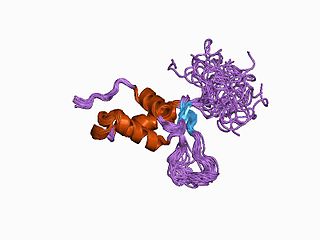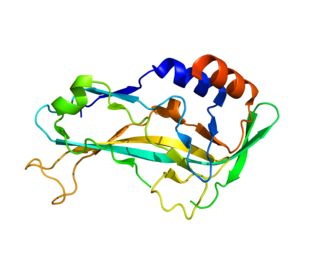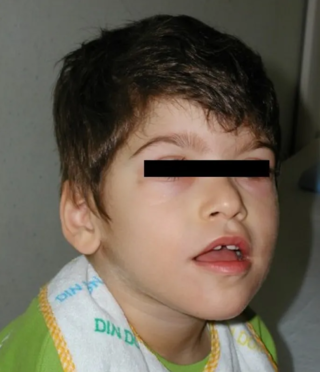Transcription factor 4 (TCF-4) also known as immunoglobulin transcription factor 2 (ITF-2) is a protein that in humans is encoded by the TCF4 gene located on chromosome 18q21.2. [5]
Transcription factor 4 (TCF-4) also known as immunoglobulin transcription factor 2 (ITF-2) is a protein that in humans is encoded by the TCF4 gene located on chromosome 18q21.2. [5]
TCF4 proteins act as transcription factors which will bind to the immunoglobulin enhancer mu-E5/kappa-E2 motif. TCF4 activates transcription by binding to the E-box (5’-CANNTG-3’) found usually on SSTR2-INR, or somatostatin receptor 2 initiator element. TCF4 is primarily involved in neurological development of the fetus during pregnancy by initiating neural differentiation by binding to DNA. It is found in the central nervous system, somites, and gonadal ridge during early development. Later in development it will be found in the thyroid, thymus, and kidneys while in adulthood TCF4 it is found in lymphocytes, muscles, mature neurons, and gastrointestinal system. [6] [7] [8]
Mutations in TCF4 cause Pitt-Hopkins Syndrome (PTHS). These mutations cause TCF4 proteins to not bind to DNA properly and control the differentiation of the nervous system. It has been suggested that TCF4 loss-of-function leads to decreased Wnt signaling and, consequently, a reduced neural progenitor proliferation. [9] In most cases that have been studied, the mutations were de novo, meaning it was a new mutation not found in other family members of the patient. Common symptoms of Pitt-Hopkins Syndrome include a wide mouth, gastrointestinal problems, developmental delay of fine motor skills, speech and breathing problems, epilepsy, and other brain defects. [10] [11]

Forkhead box protein C2 (FOXC2) also known as forkhead-related protein FKHL14 (FKHL14), transcription factor FKH-14, or mesenchyme fork head protein 1 (MFH1) is a protein that in humans is encoded by the FOXC2 gene. FOXC2 is a member of the fork head box (FOX) family of transcription factors.

Twist-related protein 1 (TWIST1) also known as class A basic helix–loop–helix protein 38 (bHLHa38) is a basic helix-loop-helix transcription factor that in humans is encoded by the TWIST1 gene.

Microphthalmia-associated transcription factor also known as class E basic helix-loop-helix protein 32 or bHLHe32 is a protein that in humans is encoded by the MITF gene.

The autoimmune regulator (AIRE) is a protein that in humans is encoded by the AIRE gene. It is a 13kb gene on chromosome 21q22.3 that has 545 amino acids. AIRE is a transcription factor expressed in the medulla of the thymus. It is part of the mechanism which eliminates self-reactive T cells that would cause autoimmune disease. It exposes T cells to normal, healthy proteins from all parts of the body, and T cells that react to those proteins are destroyed.

Transcription factor 7-like 2 , also known as TCF7L2 or TCF4, is a protein acting as a transcription factor that, in humans, is encoded by the TCF7L2 gene. The TCF7L2 gene is located on chromosome 10q25.2–q25.3, contains 19 exons. As a member of the TCF family, TCF7L2 can form a bipartite transcription factor and influence several biological pathways, including the Wnt signalling pathway.

Transcription factor 3, also known as TCF3, is a protein that in humans is encoded by the TCF3 gene. TCF3 has been shown to directly enhance Hes1 expression.

HNF1 homeobox B, also known as HNF1B or transcription factor 2 (TCF2), is a human gene.

Forkhead box C1, also known as FOXC1, is a protein which in humans is encoded by the FOXC1 gene.

DNA-binding protein inhibitor ID-3 is a protein that in humans is encoded by the ID3 gene.

Forkhead box protein L2 is a protein that in humans is encoded by the FOXL2 gene.

Transcription factor 12 is a protein that in humans is encoded by the TCF12 gene.

T-box transcription factor TBX5, is a protein that in humans is encoded by the TBX5 gene.

DNA excision repair protein ERCC-8 is a protein that in humans is encoded by the ERCC8 gene.

Transcription factor SOX-18 is a protein that in humans is encoded by the SOX18 gene.

ETS domain-containing protein Elk-3 is a protein that in humans is encoded by the ELK3 gene.

PHD finger protein 6 is a protein that in humans is encoded by the PHF6 gene.

Carbohydrate-responsive element-binding protein (ChREBP) also known as MLX-interacting protein-like (MLXIPL) is a protein that in humans is encoded by the MLXIPL gene. The protein name derives from the protein's interaction with carbohydrate response element sequences of DNA.

Twist-related protein 2 is a protein that in humans is encoded by the TWIST2 gene. The protein encoded by this gene is a basic helix-loop-helix (bHLH) transcription factor and shares similarity with another bHLH transcription factor, TWIST1. bHLH transcription factors have been implicated in cell lineage determination and differentiation. It is thought that during osteoblast development, this protein may inhibit osteoblast maturation and maintain cells in a preosteoblast phenotype.

Pitt–Hopkins syndrome (PTHS) is a rare genetic disorder characterized by developmental delay, epilepsy, distinctive facial features, and possible intermittent hyperventilation followed by apnea. Pitt-Hopkins syndrome can be marked by intellectual disabilities as well also problems with socializing. It is part of the clinical spectrum of Rett-like syndromes.

(HES7) or bHLHb37 is protein coding mammalian gene found on chromosome 17 in humans. HES7 is a member of the Hairy and Enhancer of Split families of Basic helix-loop-helix proteins. The gene product is a transcription factor and is expressed cyclically in the presomitic mesoderm as part of the Notch signalling pathway. HES7 is involved in the segmentation of somites from the presomitic mesoderm in vertebrates. The HES7 gene is self-regulated by a negative feedback loop in which the gene product can bind to its own promoter. This causes the gene to be expressed in an oscillatory manner. The HES7 protein also represses expression of Lunatic Fringe (LFNG) thereby both directly and indirectly regulating the Notch signalling pathway. Mutations in HES7 can result in deformities of the spine, ribs and heart. Spondylocostal dysostosis is a common disease caused by mutations in the HES7 gene. The inheritance pattern of Spondylocostal dysostosis is autosomal recessive.
This article incorporates text from the United States National Library of Medicine, which is in the public domain.